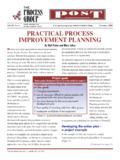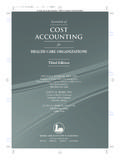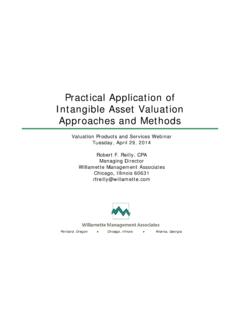Transcription of Acceptable risk - WHO | World Health Organization
1 2001 World Health Organization (WHO). Water Quality: Guidelines, Standards and Health . Edited byLorna Fewtrell and Jamie Bartram. Published by IWA Publishing, London, UK. ISBN: 1 900222 28 010 Acceptable riskPaul R. Hunter and Lorna FewtrellThe notion that there is some level of risk that everyone will find Acceptable is adifficult idea to reconcile and yet, without such a baseline, how can it ever bepossible to set guideline values and standards, given that life can never be risk-free? Since zero risk is completely unachievable, this chapter outlines some ofthe problems of achieving a measure of Acceptable risk by examining anumber of standpoints from which the problem can be INTRODUCTIONA number of chapters within this book examine the question of what is risk andhow we define it.
2 Risk is generally taken to be the probability of injury, disease,or death under specific circumstances. However, this objective measure of riskdoes not tell the whole story and, in determining acceptability of any particularrisk, perceived risk is likely to play a large Quality: Guidelines, Standards and HealthThe following is a list of standpoints that could be used as a basis fordetermining when a risk is Acceptable or, perhaps, tolerable. These will beexplored under broad risk is Acceptable when: it falls below an arbitrary defined probability it falls below some level that is already tolerated it falls below an arbitrary defined attributable fraction of totaldisease burden in the community the cost of reducing the risk would exceed the costs saved the cost of reducing the risk would exceed the costs saved when the costs of suffering are also factored in the opportunity costs would be better spent on other, more pressing,public Health problems public Health professionals say it is Acceptable the general public say it is Acceptable (or more likely, do not say itis not)
3 Politicians say it is A PREDEFINED PROBABILITY APPROACHOne definition of Acceptable risk that has been widely accepted inenvironmental regulation, although is not relevant to microbiologicalparameters, is if lifetime exposure to a substance increases a person s chance ofdeveloping cancer by one chance in a million or less. This level, which hascome to be taken as essentially zero , was apparently derived in the US in the1960s during the development of guidelines for safety testing in animal figure, for the purposes of discussion, of 1 chance in 100 million ofdeveloping cancer was put forward as safe. This figure was adopted by the Foodand Drug Administration in 1973, but amended to one in a million in 1977(Kelly and Cardon 1994).
4 This level of 10 6 has been seen as something of agold standard ever since. The US Environmental Protection Agency (EPA)typically uses a target reference risk range of 10 4 to 10 6 for carcinogens indrinking water (Cotruvo 1988), which is in line with World Health Organization (WHO) guidelines for drinking water quality which, where practical, baseguideline values for genotoxic carcinogens on the upper bound estimate of anexcess lifetime cancer risk of 10 5 (WHO 1993). Similar approaches have been adopted elsewhere and for other risks . In theUK, for example , the Health and Safety Executive (HSE) adopted the followinglevels of risk, in terms of the probability of an individual dying in any one year: Acceptable risk209 1 in 1000 as the just about tolerable risk for any substantialcategory of workers for any large part of a working life.
5 1 in 10,000 as the maximum tolerable risk for members of thepublic from any single non-nuclear plant. 1 in 100,000 as the maximum tolerable risk for members of thepublic from any new nuclear power station. 1 in 1,000,000 as the level of Acceptable risk at which no furtherimprovements in safety need to be made. The HSE set these guidelines after considering risks in other contexts, with arisk of 1 in 1,000,000 being roughly the same as the risk of being electrocuted athome and a hundredth that of dying in a road traffic accident (RCEP 1998).Interestingly, although the final figure of one in a million appears to be the sameas that followed in the US, the figure in the UK is an annual rather than lifetimerisk.
6 With regards to microbiological risks from drinking water, the US EPA,using Giardia as a reference organism, required that the microbial risk is lessthan 1 infection per 10,000 people per year (Macler and Regli 1993). The logicbehind the choice of Giardia was that it was known to be more resistant todisinfection than most other microbial pathogens (although Cryptosporidium since challenged this status ). Therefore, protection against Giardiainfection should provide protection against other organisms, with the intentionof minimising all microbial illness. It is interesting to compare the levels of protection between microbiologicaland carcinogen risk. If it is assumed that there is a 50 67% frequency of clinicalillness following infection with Giardia (Gerba et al.)
7 1996) then, using thelower bound of 50%, this translates to an annual risk of illness of 1 in 20, and colleagues do not cite a case-fatality rate for Giardia, but in thegeneral population seems to be a reasonable level based on other pathogenscausing gastrointestinal symptoms (Gerba et al. 1996; Macler and Regli 1993).This results in an annual risk of death of 1 in 20,000,000. Converting this to a70-year lifetime risk to be comparable with rates cited for chemicalcontaminants results in a risk of 1 in 2 10 5, a figure that is similar to thatconsidered Acceptable by the WHO for carcinogenic risks . The outcome of infection, however, will vary according to a number offactors and many groups within society, such as the young, elderly,malnourished and so on are more susceptible to developing illness followinginfection than the general population.
8 This is a theme that we will return toin a later section but, clearly, the level of protection will not be the same forall Quality: Guidelines, Standards and Health Examination of what is currently being achieved versus what is claimed tobe an Acceptable risk makes for interesting and sobering reading. Haas andEisenberg, in Chapter 8 of this book, outline a risk assessment of drinkingwater supplies in New York City and the risk of infection withCryptosporidium. They estimate that the risk is some two orders of magnitudegreater than the Acceptable level. Such results back up the work of Paymentand Hunter (see Chapter 4) who claimed that a very high proportion ofgastrointestinal illness could be attributed to tap water, even if it met currentwater quality A CURRENTLY TOLERATED APPROACH The basic argument here is that any risk that is currently tolerated isconsidered to be Acceptable .
9 This approach was used by the US EPA insetting the allowable bacterial indicator densities for bathing waters (US EPA1986). The work of Cabelli and Dufour (Cabelli et al. 1979, 1982, 1983;Dufour 1984) allowed Health effects, in terms of swimming-associatedgastroenteritis rates, to be estimated. It was established that previousstandards had resulted in a gastrointestinal illness rate of 8/1000 bathers atfreshwater sites and 19/1000 bathers at marine sites. These levels wereconsidered to be tolerated (as people still used the bathing areas) and weretherefore assumed to be Acceptable . The new standards were based aroundthis Acceptable level.
10 A similar approach has been suggested by Wyer et al. (1999) in theirexperimental Health -related classification for marine waters, using other riskfactors as measures of acceptability. This work was based on extensiveepidemiological studies conducted around the UK coastline that resulted in adose response relationship between the bacterial indicator faecalstreptococci and gastroenteritis experienced by bathers. The dose responserelationship was found to be independent of, and not confounded by, otherpredictors of gastroenteritis, including the transmission of gastroenteritisfrom household members (termed person-to-person transmission) and acomposite factor termed non-water-related risk.

















